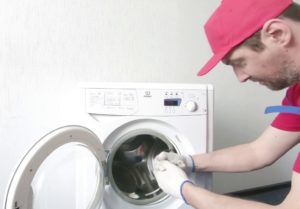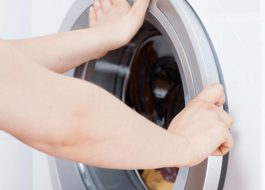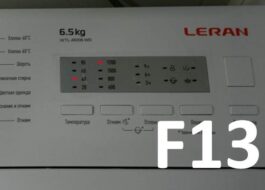The door of the Indesit washing machine does not close
 Very often, users are faced with the problem of closing the hatch in the Indesit machine. In this case, do not panic: as a rule, such issues are resolved quickly and on your own, and how to do this will be discussed in this article. It is worth noting that there are usually two types of the above problem: when the washing machine door does not close and when the door does not lock. For your convenience, we will consider these cases separately, since most often they are not interrelated.
Very often, users are faced with the problem of closing the hatch in the Indesit machine. In this case, do not panic: as a rule, such issues are resolved quickly and on your own, and how to do this will be discussed in this article. It is worth noting that there are usually two types of the above problem: when the washing machine door does not close and when the door does not lock. For your convenience, we will consider these cases separately, since most often they are not interrelated.
Damage to the door itself
In this case, the door lock of the Indesit machine does not actually close. In such a situation, when the door is closed, the hatch will not stay in the closed position (you cannot hear a characteristic click, after which the door is considered closed), or it will simply open. The following option is also possible: when closing the hatch, it will seem to you that something is preventing it from slamming shut, as if an obstacle has appeared against which the hatch rests. The reasons for this behavior of the door are varied.
- Your door is warped. Washing machine doors tend to warp over time with heavy use; this is absolutely normal. Therefore, check whether everything is fine with it, whether the hook fits into the special hole. If you find a problem, the door can be adjusted using the mounting bolts.
- The tongue, the device that directly holds the door closed, has broken. It, in turn, is held in place by a special metal rod, which could easily fall out. With the problem described above, all that is needed is to disassemble the door and return the rod to its original position.
- Some other part could have broken in the door itself - a hook, for example. In this case, the only solution is to replace the door handle of your device.
 If the lock does not lock in the closed position or the door simply opens when released, the problem is most likely in the plastic guide. This part is built into some washing machine models and tends to wear out. Your door may warp very slightly, this will not affect the operation of the washing unit in any way, but sooner or later you will encounter the problem of wear on the plastic guide. Where it leads? The hook will no longer stay in the groove, and the hatch simply will not close until it clicks. What to do in this case?
If the lock does not lock in the closed position or the door simply opens when released, the problem is most likely in the plastic guide. This part is built into some washing machine models and tends to wear out. Your door may warp very slightly, this will not affect the operation of the washing unit in any way, but sooner or later you will encounter the problem of wear on the plastic guide. Where it leads? The hook will no longer stay in the groove, and the hatch simply will not close until it clicks. What to do in this case?
- unscrew the fasteners connecting the door to the hinge using a torx screwdriver;
- unscrew the screws located on the inside of the door in a circle, having first removed it from the hinge;
- pry the door halves with something sharp and disassemble it;
- inspect the opening mechanism to find the problem.
Unfortunately, the mechanisms are rarely sold separately, so most likely the entire door will have to be replaced. However, if the damage is not so serious (a spring has fallen out or the rod has jumped out), you can repair the mechanism on your own.
Be careful when performing such operations so as not to damage any other part of your washer. In rare cases, such manipulations can lead to even greater consequences if basic caution is neglected. Be extremely careful!
When the hatch closes but does not lock
To understand the essence of this problem, imagine the following picture: you close the hatch door, it obediently latches, but the washer points you to the open hatch and refuses to start washing. What is the problem? Most likely, the hatch locking device (abbreviated as UBL) has broken down or the control module has failed.
So, the UBL is faulty, which means the door does not lock and the washing does not start. The hatch locking device works as follows: it is energized and locks the hatch. Accordingly, the UBL is faulty - no washing!
In addition to breakdown, there is a possibility that the UBL is simply clogged. Moreover, it could become clogged with anything, especially if there are small children in the house. This problem can be solved almost instantly: just check the lock and clean it if necessary.
But dysfunction of the electronic module is a more serious cause for concern. The module is designed to send a corresponding signal to the hatch blocking device, but in the event of a breakdown this does not happen. This is why your door is not locked. The module may burn out from a voltage surge, or its software may suddenly crash - in any case, you need to call a repairman. He will either replace the module or install the software again, depending on the type of failure.
Testing UBL
To check the operation of the lock, there is a special tester (the most suitable option is a multimeter with a large range). However, in order to use such a device, the hatch door must be removed.
- Loosen the clamp that holds the front wall cuff in position.Depending on the clamp (and they are different), use either round-nose pliers, a screwdriver, or pliers.
- To find the UBL, you need to remove the cuff from the front wall.
- Remove the two screws (that hold the lock in position) from the outside where the lock hook contacts the lock device.
- Disconnect the wires and remove the UBL (it is no longer secured) through the hole between the cuff and the machine body.
In order to proceed further, it is necessary to study the special hatch lock diagram. As a rule, such a device is found in almost any car, but each company installs it in its own way (the contacts are different), and we need to know the purpose of each contact in advance, otherwise nothing will work. Find such a diagram on the Internet and find out where the phase, neutral, and common contacts are. Only after this is it possible to check the blocking with a tester.
- The device toggle switch must be switched to resistance test mode.
- Place the probe on the neutral and phase contacts of the lock.
- After this, the device should show a three-digit number.
- Next, the probes should be installed on the common and neutral contacts.
- If you see 0 or 1 on the device, this indicates a malfunction of the device.
As can be seen from our story, some defects in your machine can be eliminated with little effort and almost instantly, while some will require a certain amount of effort and time. However, in any case, these problems can be solved both independently and with the help of a specialist.
Interesting:
Reader comments
- Share your opinion - leave a comment
Categories
Washing machine repair


For buyers

For users

Dishwasher

















Add a comment